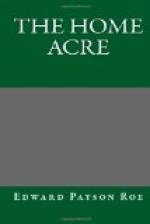In this chapter and in those which may ensue I merely hope to make some useful suggestions and give practical advice—the result of experience, my own and others’—which the reader may carry out and modify according to his judgment.
We will suppose that an acre has been bought; that it is comparatively level, with nothing of especial value upon it—in brief, that the home and its surroundings are still to be created.
It is not within my design to treat of the dwelling, its architecture, etc., but we shall have something to say further on in regard to its location. Before purchasing, the most careful investigations should be made as to the healthfulness of the region and the opportunities for thorough drainage. Having bought the acre, the question of removing all undue accumulations of water on or beneath the surface should be attended to at first. The dry appearance of the soil during much of the year may be misleading. It should be remembered that there are equinoctial storms and melting snows. Superabundant moisture at every period should have channels of immediate escape, for moisture in excess is an injury to plant as well as to family life; while thoroughly and quickly drained land endures drought far better than that which is rendered heavy and sour by water stagnating beneath the surface. Tile-drains are usually the cheapest and most effective; but if there are stones and rocks upon the place, they can be utilized and disposed of at the same time by their burial in ditches—and they should be covered so deeply that a plow, although sunk to the beam, can pass over them. Tiles or the top of a stone drain should be at least two feet below the surface. If the ground of the acre is underlaid with a porous subsoil, there is usually an adequate natural drainage.
Making haste slowly is often the quickest way to desired results. It is the usual method to erect the dwelling first, and afterward to subdue and enrich the ground gradually. This in many instances may prove the best course; but when it is practicable, I should advise that building be deferred until the land (with the exception of the spaces to be occupied with the house and barn) can be covered with a heavy dressing of barnyard manure, and that this be plowed under in the autumn. Such general enriching of the soil may seem a waste in view of the carriage-drive




